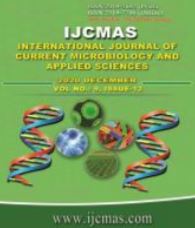


 National Academy of Agricultural Sciences (NAAS)
National Academy of Agricultural Sciences (NAAS)

|
PRINT ISSN : 2319-7692
Online ISSN : 2319-7706 Issues : 12 per year Publisher : Excellent Publishers Email : editorijcmas@gmail.com / submit@ijcmas.com Editor-in-chief: Dr.M.Prakash Index Copernicus ICV 2018: 95.39 NAAS RATING 2020: 5.38 |
Bacillus cereus is major spoilage microorganism in dairy products causing foodborne illness. In recent days, food safety is widely becoming an important public health issue, as foodborne diseases present a global public health problem. The rapid and precise monitoring and detection of foodborne pathogens are some of the most effective ways to control and prevent foodborne illness. In the present study, magnetic nanoparticles (MNPs) were prepared and characterized by particle size analyser, Zeta potential, X-ray diffraction (XRD) spectrophotometer analysis, Fourier Transform Infrared Spectroscopy (FTIR) and UV-visible spectrophotometer analysis. The results of the synthesized nanoparticles had particle size of 128 nm and zeta potential value of -50.8 ±2.2 mV. Crystal size of nanoparticle analysed by XRD was 51.24 nm. The magnetic nanoparticle were coupled with antimicrobial peptide cecropin and was utilized for entrapment of foodborne pathogens from milk and milk products followed by magnetic separation and PCR detection targeting HL gene of B. cereus. Further evaluation of nanoarticle entrapment and PCR, 150 food samples were screened for the presence of B.cereus in milk and milk products, which had improved detection sensitivity with 32% positivity in magnetic nanoparticle mediated entrapment followed by PCR when compared to 19% positivity in direct pelleting and PCR method.
 |
 |
 |
 |
 |